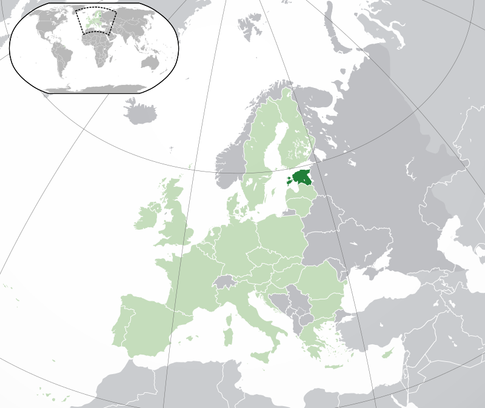FLAG OF ESTONIA
- Jakub Miniewski
- Dec 27, 2016
- 4 min read
The national flag of Estonia is a tricolour featuring three equal horizontal bands of blue, black, and white. In Estonian it is colloquially called the "sinimustvalge" (literally "blue-black-white"), after the colours of the bands.
There are a number of interpretations attributed to the colours of the flag. A historical interpretation of the colours has blue representing ancient freedom, truth, sky and sea, black symbolizing soil, lost independence and dark coats, and white, the promise and pursuit of a brighter future.
The story of the flag begins on 17 September 1881, when the constituent Assembly of the first Estonian national student Corps "Vironia" (modern Estonian Students Society) in the city of Tartu was also identified in colour, later became national.
The flag became associated with Estonian nationalism and was used as the national flag when the Estonian Declaration of Independence was issued on February 24, 1918. The flag was formally adopted on November 21, 1918. December 12, 1918, was the first time the flag was raised as the national symbol atop of the Pikk Hermann Tower in Tallinn.
The invasion by the Soviet Union in June 1940 led to the flag's ban. It was taken down from the most symbolic location, the tower of Pikk Hermann in Tallinn, on June 21, 1940, when Estonia was still formally independent. On the next day, 22 June, it was hoisted along with the red flag. The tricolour disappeared completely from the tower on July 27, 1940, and was replaced by the flag of the Estonian SSR.
During the German occupation from 1941 until 1944, the flag was accepted as the ethnic flag of Estonians but not the national flag. After the German retreat from Tallinn in September 1944, the Estonian flag was hoisted once again.
When the Red Army arrived for the second time, after the World War II, the red flag was just added at first. Soon afterwards, however, the blue-black-white flag disappeared. In its place from February 1953, the Estonian SSR flag was redesigned to include the six blue spiked waves on the bottom with the hammer and sickle with the red star on top.

The flag remained illegal until the days of perestroika in the late 1980s. 21 October 1987 was the first time when Soviet forces didn't take down the flag at a public event. 24 February 1989 the blue-black-white flag was again flown from the Pikk Hermann tower in Tallinn. It was formally re-declared as the national flag on 7 August 1990, little over a year before Estonia regained full independence.
In 2001, politician Kaarel Tarand suggested that the flag be changed from a tricolour to a Scandinavian-style cross design with the same colours. Supporters of this design claim that a tricolour gives Estonia the image of a post-Soviet or Eastern European country, while a cross design would symbolise the country's links with Nordic countries. Several Nordic cross designs were proposed already in 1919, when the state flag was officially adopted.

As the tricolour is considered an important national symbol, the proposal did not achieve widespread popularity.
Estonians consider themselves a Nordic nation rather than Baltic, based on their cultural and historical ties with Sweden, Denmark and particularly Finland. In December 1999 Estonian foreign minister—and current president since 2006—Toomas Hendrik Ilves delivered a speech entitled "Estonia as a Nordic Country" to the Swedish Institute for International Affairs. Diplomat Eerik-Niiles Kross even suggested changing the country's official name in English and several other foreign languages from Estonia to Estland (which is the country's name in Danish, Dutch, German, Swedish, Norwegian and many other Germanic languages).

ABOUT ESTONIA:
Estonia is a country in the Baltic region of Northern Europe. It is bordered to the north by the Gulf of Finland, to the west by the Baltic Sea, to the south by Latvia (343 km), and to the east by Lake Peipus and Russia (338.6 km). Across the Baltic Sea lies Sweden in the west and Finland in the north. The territory of Estonia consists of a mainland and 2,222 islands and islets in the Baltic Sea, covering 45,339 km2 (17,505 sq mi) of land, and is influenced by a humid continental climate.
The territory of Estonia has been inhabited since at least 6500 BCE, with Finno-Ugric speakers – the linguistic ancestors of modern Estonians. Following centuries of successive Teutonic, Danish, Swedish, and Russian rule, Estonians experienced a national awakening that culminated in independence from the Russian Empire towards the end of World War I. During World War II, Estonia was occupied by the Soviet Union in 1940, then by Nazi Germany a year later and was again annexed by the Soviets in 1944, after which it was reconstituted as the Estonian Soviet Socialist Republic. In 1988, during the Singing Revolution, the Estonian Supreme Soviet issued the Estonian Sovereignty Declaration in defiance of Soviet rule, and independence was restored on 20. August 1991.
Modern Estonia is a democratic parliamentary republic divided into fifteen counties; its capital and largest city is Tallinn. With a population of 1.3 million, it is one of the least-populous member states of the European Union, Eurozone, North Atlantic Treaty Organisation (NATO), OECD and Schengen Area.
Ethnic Estonians are a Finnic people, sharing close cultural ties with their northern neighbour, Finland, and the official language, Estonian, is a Finno-Ugric language closely related to Finnish and the Sami languages, and distantly to Hungarian.
CAPITAL OF ESTONIA:
Tallinn




コメント